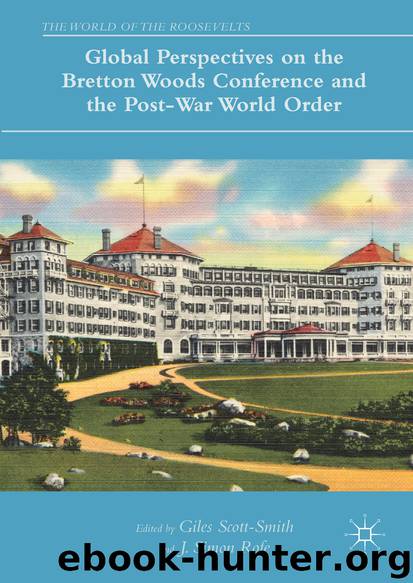Global Perspectives on the Bretton Woods Conference and the Post-War World Order by Giles Scott-Smith & J. Simon Rofe

Author:Giles Scott-Smith & J. Simon Rofe
Language: eng
Format: epub
Publisher: Springer International Publishing, Cham
The Build-Up to Bretton Woods
It was in this context, and after White had secured a resolution supporting an International Stabilization Fund at the meeting of Western Hemisphere foreign ministers at Rio, that a team of Mexican experts began to consider in earnest US plans for the postwar institutions, having received White’s April 1942 draft in July of that year. 19 When the next draft of White’s plan was officially circulated for comment in April of 1943, the Banco de México delegated a team, including Urquidi and the young economist Daniel Cosío Villegas , to draft a formal study of the plan. 20 Contrary to the conventional wisdom that the Latin American nations simply endorsed the US plans, the Mexican reports are in fact far from reverential. One of the main objections raised by the Mexican team was regarding the institutionalization of US power in the new organization: “In the end, the project… is not so ‘heroically international’ as some journalist has commented.” Instead, they wrote, “there have presided at a rather close distance North American interests, prejudices, fears and ideas.” In fact, the Mexicans not only understood the new power of the United States in the world economy, but also argued that many of the world’s present problems actually derived from that power: “This situation, painted in broad strokes, is that the United States is a country that wants to sell, but not buy; and what’s more that it’s a creditor that does not invest but hoards.” 21
Further, Urquidi and Cosío Villegas judged that the success of any new organization would require “taking very seriously the situation, needs and wishes of the debtor countries, in the process of economic development, anxious to accelerate their progress, which at the end of the day are the majority of those that exist.” 22 As Puig had argued at Montevideo, without these considerations, an international agreement would fail to correct the problems of the world economy. By July 1943, the Mexican team had seen second and third iterations of the White Plan and began to consider what Mexico ’s official position on the organizations should be. While much attention was being devoted to the new Monetary Fund, the Mexican experts reiterated that the Fund would only be useful as part of a larger set of institutions that would address the particular problems of the less-industrialized world, especially primary commodity producers. Mexico should “consider not just the advantages and drawbacks of the Fund,” they wrote, “but of the other institutions whose organization and functions are already set down: the Bank of Reconstruction and Development, and, at least, an organization whose field of work will be the production, distribution and pricing of primary products.” As to the Fund itself, the Mexican experts worried, it seemed that the proposals were “turning away each time more from the possibility of resolving, or helping to resolve, the fundamental economic problem of the next few years: the profound disturbance that the excessive wealth of the United States represents in the world.
Download
This site does not store any files on its server. We only index and link to content provided by other sites. Please contact the content providers to delete copyright contents if any and email us, we'll remove relevant links or contents immediately.
Pale Blue Dot by Carl Sagan(4613)
The Rules Do Not Apply by Ariel Levy(4523)
Goodbye Paradise(3446)
Ogilvy on Advertising by David Ogilvy(3327)
Delivering Happiness by Tony Hsieh(3282)
Liar's Poker by Michael Lewis(3222)
Into Thin Air by Jon Krakauer(3130)
Purple Cow by Seth Godin(3069)
Rogue Trader by Leeson Nick(2824)
The Social Psychology of Inequality by Unknown(2763)
The Airbnb Story by Leigh Gallagher(2700)
4 - Harry Potter and the Goblet of Fire by J.K. Rowling(2530)
The Mind Map Book by Tony Buzan(2415)
Bossypants by Tina Fey(2373)
All the President's Men by Carl Bernstein & Bob Woodward(2261)
Claridge's: The Cookbook by Nail Martyn & Erickson Meredith(2257)
Six Billion Shoppers by Porter Erisman(2226)
Master of the Game by Sidney Sheldon(2182)
Alibaba by Duncan Clark(1979)
